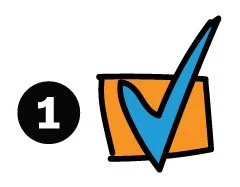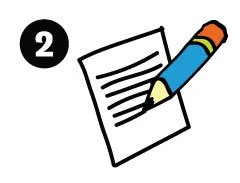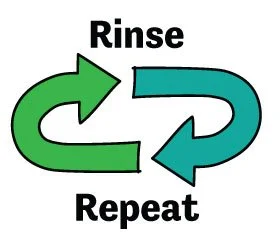3 Easy Steps for Intentional and Strategic Goal Setting
The new year is often ripe with people creating resolutions on what they want to achieve in the 365 days to come. But why do we set resolutions rather than goals? Let’s take a look at the difference between the two.
Resolutions
Resolutions are firm decisions whether or not you will do something.
Goals
Goals are a target for achievement; the desired result for your efforts.
Can you feel the difference between these definitions?
Goals tend to give us a bit more grace and room to pivot. They’re something to work towards, and they require a process. Of course, we always aim to reach our goals, but if we don’t, we can at least say we inched closer to them when we’ve stuck with a plan.
Resolutions tend to be a bit harsher. We set them in stone, and they either happen or don’t. This is because there’s no plan, and therefore no action!
While you can set goals any time of the year, new beginnings—like a new calendar year, a new school year, or a new season—tend to be good markers.
In this blog post, I offer a step-by-step process for you to try so that you can experience a successful pathway to achieving your goals, inspired by my Teacher’s Toolkit for Independent Reading work with bestie and co-author, Gravity Goldberg!
Grab your notebook, a stack of sticky notes, and your favorite pen. Let’s give it a go!
3-Step Goal-Setting Process
Step 1: Set Your Goal & Purpose
“When you know your why, your what becomes more impactful because you’re walking towards or in your purpose. Know your why.”
—Michael Jr.
Sometimes, I find that I give up on my goals too soon.
One reason I give up is that I haven’t first adapted my mindset to the bigger picture purpose. If I’m setting goals without purpose, it often ends up feeling like a lot of little projects that may be well-intentioned but never really add up to anything.
But when I start with grounding my mindset in the bigger picture, the purpose of my goal becomes clear and something I can tether the entire process to.
For example, when I set out to run a 5K, part of the big picture of that goal is to, of course, finish the race, but perhaps more importantly the parallel to crossing the finish line is the big picture work of my overall fitness and a healthy lifestyle, which in turn bring joy and overall happiness to my day-to-day living.
I begin the goal-setting process by thinking of my purpose, my why, from which I can ground the action plan in.
So, what are the reasons you want to work on this goal?
Take a few minutes to write in your notebook. Use the questions below to help you get started in your brainstorming.
What’s my why?
When did I first become passionate about teaching?
In what ways do I envision my work will improve the good of the world?
What are my blind spots and bias that I need to be aware of
And make it personal.
What am I excited to think about?
What are the areas that I’m a bit nervous to study but know that I can do it!
Pro Tip: Check to make sure that your goal is centered around your professional study and learning. As teachers, so much of the work you think about is student-centered, therefore, it might help to incorporate both in your goal-setting work.
The impact of your professional learning and goal setting and professional study will not only impact your joy and growth, but it will also impact student achievement. Look at these sample sentence starters below to study the difference between a student-driven focus and teacher-centered focus.
You can use this set of sentence starters to help you draft your goal.
Choosing and Articulating a Goal
I’m choosing to study ………………. because I’ve noticed………………..
I’ve noticed …………………. therefore, I’m choosing to study ………………..
I’m curious about ……………... and therefore, I’m prioritizing my professional study about ……….... because ………………..
Step 2: Create an Action Plan
“A goal without a plan is just a wish.”
—Antoine de Saint-Exupéry
Calendar
Calculate Simple Next Steps
Consult Research & Resources
An additional system to strategically design and plan for in your goal-setting process is attainability.
The goal-setting process is exciting for me and sometimes I get a bit carried away with trying to conquer the world. Literally. When I pull back on the reins of reality a bit, I realize that in order to conquer the world, I’ve got to take it on one small bit at a time.
For example, if my goal is to run a 5K, rather than going out and running a 5K on day one and risking the inevitable failure that ensues after a year of sitting on the couch...I might instead create some calculated steps in an action plan.
A helpful tool to use in this step of the goal-setting process is a calendar. I find that setting tiered goals that are calculated and calendared often help in getting me out the door to starting my action plan.
Running a 5k on day one is overwhelming and not something I’m fit to achieve at the moment. But instead, if I calendar 5 days in a row of calculated walking for 30 minutes each day, I can do that. Bite-size increments of success release those dopamine hits in your brain and often provoke engagement and inspiration to keep going!
The last step is consulting what other research or resources might help. For example, one tip I use in my 5k goal is listening to favorite songs or podcasts while walking. It helps inspire engagement. If you need a recommendation, you can check out my podcast here on your next walk.
Step 3: Reflect on Your Goals
What surprised you about the goal setting process?
Name something you can celebrate about this process?
What are you still working on?
What was revealed as a result of this process?
Place a date on the calendar to prioritize a check in with your goals. On this date, set aside a few minutes to think about where you are with your goals, jot down your thoughts in your notebook, or discuss with a thinking partner.
You can use the following questions to provoke your reflection.
What surprised you about the goal-setting process?
Name something you can celebrate about this process.
What are you still working on?
What was revealed as a result?
Bonus questions to ask yourself:
What did you learn about yourself?
What did you learn from others?
The last consideration of successful goal setting is an important one - YOU! Nobody else can really set a goal for you.
Part of what should motivate you on your goal-setting journey is the autonomy to design your own and making goal-setting action plans personal.
You think it. You plan it. You do it. You celebrate it!
And there you go! You’ve got a 3-step process to help you be a goal setter!
Applying This Goal-Setting Process to Your Work
Principals - Use this goal-setting process to support conversations with your team this winter and spring. Let’s bring a little joy to teaching by identifying an area of interest to pursue in professional study.
Teachers - Use this goal-setting process with your colleagues to DIY your professional study and learning this winter and spring! You can also teach this same goal-setting process with students. Imagine kicking off the year with a conversation about the class community vision for what you want to achieve together. Teach students to set goals in all areas of their lives.
Caregivers - Use this goal-setting process with the children in your life. How can you incorporate goal-setting into your everyday life? Maybe it starts with something as small as less screen time and more outdoor time.
Wrapping It Up
When you move through a goal-setting process, you are taking an idea and turning it into a reality by creating an action plan. That plan of action will help keep the momentum moving forward in daily life.
That action plan helps avoid overload and decision fatigue. When you have a clear plan of action, you preserve your mental energy from scattering to the wind.
It’s not actually about hitting the mark of your goal. The reason it’s called a goal-setting process is that that’s exactly what it is: a process.
The important thing to remember about processes, in general, is they are a set of procedural experiences that are designed to be on a rinse and repeat cycle. As is the case with most things in life, the more you do something, the better you get at it. It’s true with goal setting, too.
Typically what happens with the goal-setting process is you set out with one goal in mind. You create an action plan, and you set it in motion. Once you’re in it, you discover something new. That discovery often becomes a pathway to more opportunities, and over time, more success.
More goals. More action plans. More discovery.
Rinse and repeat.
With this in mind, it’s possible you may not ever hit the mark of that original goal, but what you are doing is discovering pathways that are opening up through your efforts, energy, and attention to the plan.
Your goal-setting process opens up endless possibilities. It’s very fun and very exciting—when you have a plan in place!









